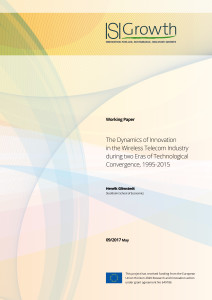This paper traces the changing dynamics and strategies of innovation in wireless infrastructure industry, covering three major phases: (1) massive adaptation of wireless services in the 1990s and the Internet Cries, (2) the smartphone revolution and the trends to commoditization of wireless systems and (3) search for new profitable growth in services, cloud and Internet-of-Things. It analyses the development of the specific industry character: role of open industry standards as pathways for innovation, the continuous leadership of vertically integrated incumbent system integrating vendors, the regionalization of communication markets, and the development of telecom regulations. It shows how the equipment industry’s continuous massive R&D efforts (i.e. 3G, HSPA, HSPA+ and 4G wireless systems) enabled the smartphone revolution, whilst the intensive competition among wireless operators trickled down to the incumbent equipment vendors in terms of a lethal mix of requirements for high-performing equipment and very competitive pricing, a combination which undermined vendor’s margins. In the process, industry incumbents shared new generations of technologies with new innovative Asian entrants through the open standards regime, leading to more global and heated competition. As the competition developed from “regionalized and moderate” to “globalized and intensive”, both European incumbents and Asian entrants explored services and software as new areas of profitable growth. In particular, the paper analyses how the industry players, in stiff competition with the ‘IT giants’ and platform leaders of the Internet economy, are seeking leadership in cloud and Internet-of-Things through the launch of the 5th Generation wireless services, to be standardized in 2020. To explain the competitive outcomes in the different periods outlined above we need to link two levels of the analysis:
• Firm Level Sources of Competitiveness
Strategic commitments and business models
Governance of internal resource allocation and the social organizational integration of knowledge, capabilities and resources within the company, as well as with external suppliers and partners
Financial resource commitments
• Standards and the Industry Architecture
Governance of wireless standard setting processes, regional and global
Governance of and business models for knowledge integration of evolving technologies within generations of standards
Short-term and long-term impact of industry architecture on firm- level performance
The Dynamics of Innovation in the Wireless Telecom Industry during two Eras of Technological Convergence, 1995-2015
Henrik Glimstedt
Stockholm School of Economics

